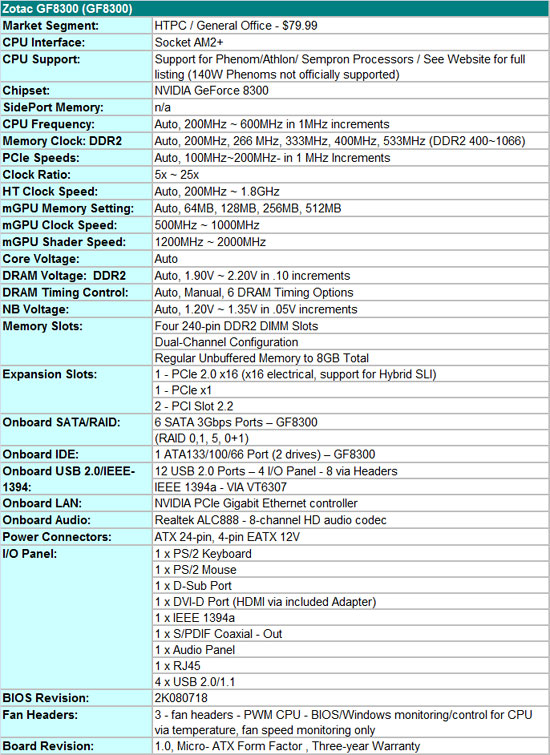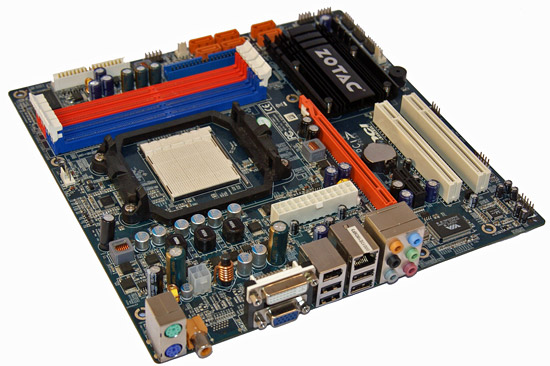The IGP Chronicles Part 2: AMD 780G vs. Intel G45 vs. NVIDIA GeForce 8200
by Gary Key on October 14, 2008 12:40 PM EST- Posted in
- Motherboards
NVIDIA GeForce 8300 by Zotac
Our second board is the Zotac GF8300 and it represents one of their first forays into the motherboard market. This board is a no-frills affair from the BIOS options down to the feature set. However, sometimes this is the best course to take in the low-end market; providing a high quality board that just gets the job done is a plus in our book. That also means that you need to get it right the first time.

Did Zotac get it right the first time? Not exactly, as this board has a couple of layout nuisances in our book. The placement of the 24-pin ATX power connector is in the wrong spot for most case designs and interferes with both airflow and cable management around the CPU area. It is something you can live with but we have seen better on other uATX boards. If you do utilize a dual slot GPU card (a rare event on these boards) then expect to lose the only PCIe x1 slot on the board and two SATA ports. Otherwise, the placement and design of the GF8300 heatsink scores points with us.

The BIOS design and options are minimalistic but do provide base functionality and the ability to overclock slightly. The BIOS is missing Core Voltage settings, something that we expect on all boards in this category - not just for the ability to overclock but also to undervolt the CPU when using the board in an HTPC setup.
The options on the board are decent, ranging from IEEE 1394a support from the VIA VT6307 to HD audio from the Realtek ALC888 (no real-time DTS or DD support) along with RAID 0, 1, 0+1, and 5 support. Zotac provides VGA and DVI-D outputs but notably missing is native HDMI. However, we did not have any problems utilizing the included DVI to HDMI adapter when running 7.1 channel HDMI audio out to our receiver. Zotac does offer decent CPU fan controls and monitoring; system fan control is missing but the BIOS does monitor fan speeds.
Zotac utilizes an excellent 3-phase power delivery system along with quality capacitors throughout the board that resulted in very good stability throughout our testing regimen. This board does not support the 140W TDP processors, although Zotac rates it for the 125W TDP processors provided there is good airflow across the PWM area. We have not had any problems with either the 9850BE or 9950BE in several hundred hours of testing, though the MOSFETs like squeal at times when under heavy loads. We recommend sticking to the Tri-Core Phenoms on this board; they also happen to be an excellent value/choice for HTPC or gaming at this time.
Without an overclocking friendly BIOS, we still managed to get our 8750e up to 235HTT and our 4850e to 232HTT before requiring core voltage for stability. We did not overclock our 9950BE in the hopes of saving the board from an early grave. The GF8300 is nothing more than a binned GF8200 and it shows on this board with mGPU shader clocks hitting 1750 MHz and mGPU core clock hitting 710 MHz.
Pros/Cons
We can sum this up quickly. The GF8300 is a good first try for Zotac in the AMD motherboard market. We hope that they will learn from a couple of layout mistakes on the next board. The BIOS needs core voltage settings and we would like to see native HDMI output along with an eSATA option. These boards will likely find their way into HTPC or SOHO setups and these options are important; in fact, a better audio solution would be nice also. Otherwise, the board was extremely stable during testing and we never once had a compatibility problem or a blue screen. Not too many boards can say that and for this reason, we placed the Zotac GF8300 high on our list, as stability is paramount in a system.














41 Comments
View All Comments
tonyintoronto - Wednesday, October 15, 2008 - link
The issue is the 780G just doesn't work well enough to be used in htpc.. tons of issues with hdcp and different monitors/tv's, still can't decode mpeg2 stream without crashing the display driver, issues with open GL, was a great idea but bad drivers/hardware have done it for me.. now, the 9300 and 9400 looking nice :)Mathos - Tuesday, October 14, 2008 - link
Hmmmmm Actually the power numbers aren't too bad when you take it into context. Q9300 is a 45nm chip, and 9950 is 65nm. Q9300 is 95w TDP rated, but runs much lower actual TDP. While the 9950 is rated 125w TDP. I'd be interested in seeing this test redone once Deneb variants come out. Considering the lesser performance of the Phenom compared to the Penryn, it actually speaks well of both the AMD based chipsets, and shows that the 790GX does a lot to make up for the processor.I'd say AMD/ATI are doing a good job on the Chipset front now.
Calin - Tuesday, October 14, 2008 - link
Also, considering we're talking about a $174 versus a $260 processor. I wonder what the results were if the comparation would have been against the quad core Q6600 (at a somewhat similar price of $189).3DoubleD - Tuesday, October 14, 2008 - link
"However, they are offering 8-channel LPCM support on the HD 4xxx series of video cards. Of course that option comes with an additional cost and potential problems such as incompatibility with AVR receivers such as those from Yamaha"Can you elaborate on these problems? I was planning on building an HTPC system and was considering this exact combination. Are these temporary (driver update solvable) problems?
This second question is only distantly related to this article. When using the HDMI with LPCM audio, will sound from sources other than Blu-ray discs (such as games or movies with DD5.1 or DTS) be playable on your stereo? Part of me wants to say yes it will for DTS and DD5.1, but I'm skeptical about video games for some reason. I guess I don't fully understand the extent of the sound card capabilities on these IGP/discrete graphics solutions.
Great article, I'm looking forward to your HTPC graphics card review.
AmdInside - Tuesday, October 14, 2008 - link
I own the Asus M3N-H/HDMI (Geforce 8300) and except for the fact that it doesn't have an eSATA port, I have no complaints (well, maybe the placement of the 24-pin power connector).http://www.asus.com/products.aspx?modelmenu=1&...">http://www.asus.com/products.aspx?model...mp;l1=3&...
I recently purchased the Intel G45 Mini-ITX motherboard to build a second HTPC and although it has worked ok for the most part, BD and HD-DVD playback just doesn't seem as smooth as the Geforce 8300. It is not choppy. It just feels like the framerate is lower. I can't explain why. The same HDTV was used with both systems and they were both set to 1080p/60. Both systems are running Windows Vista. If you are building a new HTPC, I would not recommend Windows XP btw with these platforms. Anyways, I appreciated the article. For me, I was trying to build a somewhat portable HTPC with the Intel mini-ITX motherboard but given the problems I am having with BD and HD-DVD playback, I think I am going to leave it as a Windows Media Center DVR box and use the Geforce 8300 as my main HTPC. For what it's worth, I tested with both WinDVD and Arcsoft TMT.
gipper - Tuesday, October 14, 2008 - link
It sounds to me like you're really recommending that at this time the way to go is to get a cheap Intel chipset motherboard with the cheapest, lowest power 45nm Core2 Duo, and an ATI 4550.But what Intel chipset would give that rock solid platform at the lowest price?
tayhimself - Tuesday, October 14, 2008 - link
Neither AMD nor Nvidia can make a decent chipset. Intel seems to have as many misses as they have hits so they're usually a good bet. Boo hiss to poor QC!Nil Einne - Friday, January 30, 2009 - link
As with others, I have to say this is a piss poor review. I looked at the Part 1 and came across a resonably decent review. Was expecting the same thing here. But what do I come across? You onmly test two quad cores. What idiot buys a quad core for their HTPC? Unless you're transcoding there's absolutely no reason and given the price of HDs nowadays and the fact that some broadcasters are using AVC for their HD content anyway there's only a few people who are going to bother. Even if you are occasionally transcoding, it's questionable of you really need a quad core or it might be better to just stick with a dual. At the very lest you could have tested quad cores and dual cores like you did with the previous review. But you didn't and so have a fairly useless review for 99% of the population. Why did you even bother with gaming anyway? Seriously, how many people game with quad core IGP systems particularly the kind of games you were testing. And how many of those check out Anandtech reviews? Maybe 5 people in the whole world... You may use a quad core IGP for a high load server or a non-3D workstation but not gaming.As it stands, based on your previous review (part 1, i.e. the one with the G35) and your comparison between the G35 and G45 I'm guessing that the 8200 is probably still better when paired with a decent CPU for most HTPC purposes but only barely. Sadly it's just a guess for the reasons I outlined above
Nil Einne - Friday, January 30, 2009 - link
When I said part 1 I meant the "IGP Power Consumption - 780G, GF8200, and G35", got slightly confused. One of the strangest things about this review of course is the 8200 performed so poorly whereas in that review, it was better then the 780G. Has the 780G improved a lot? Is it just the Gigabute 780G was a POS? Who knows, one would have thought the reviewer would have at least co=mmented on if not investigated this but apparently notlisajack - Saturday, January 18, 2020 - link
Although, with MMA corner standards, I wouldn’t be surprised if somebody told her to go out there and do her best despite being completely out(weight)classed by the scale.<a href="https://www.nogibjjgear.com/collections/rash-guard... guards</a>